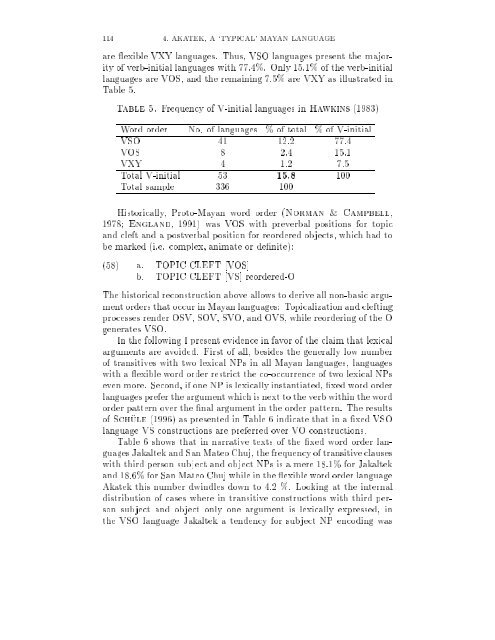Perception verb complements in Akatek, a Mayan language
Perception verb complements in Akatek, a Mayan language
Perception verb complements in Akatek, a Mayan language
You also want an ePaper? Increase the reach of your titles
YUMPU automatically turns print PDFs into web optimized ePapers that Google loves.
114 4. AKATEK, A `TYPICAL' MAYAN LANGUAGE<br />
are exible VXY <strong>language</strong>s. Thus, VSO <strong>language</strong>s present the majority<br />
of<strong>verb</strong>-<strong>in</strong>itial <strong>language</strong>s with 77.4%. Only 15.1% of the <strong>verb</strong>-<strong>in</strong>itial<br />
<strong>language</strong>s are VOS, and the rema<strong>in</strong><strong>in</strong>g 7.5% are VXY as illustrated <strong>in</strong><br />
Table 5.<br />
Table 5. Frequency of V-<strong>in</strong>itial <strong>language</strong>s <strong>in</strong> Hawk<strong>in</strong>s (1983)<br />
Word order No. of <strong>language</strong>s % of total % of V-<strong>in</strong>itial<br />
VSO 41 12.2 77.4<br />
VOS 8 2.4 15.1<br />
VXY 4 1.2 7.5<br />
Total V-<strong>in</strong>itial 53 15.8 100<br />
Total sample 336 100<br />
Historically, Proto-<strong>Mayan</strong> word order (Norman & Campbell,<br />
1978; England, 1991) was VOS with pre<strong>verb</strong>al positions for topic<br />
and cleft and a post<strong>verb</strong>al position for reordered objects, which had to<br />
be marked (i.e. complex, animate or de nite):<br />
(58) a. TOPIC CLEFT [VOS]<br />
b. TOPIC CLEFT [VS] reordered-O<br />
The historical reconstruction above allows to derive all non-basic argument<br />
orders that occur <strong>in</strong> <strong>Mayan</strong> <strong>language</strong>s: Topicalization and cleft<strong>in</strong>g<br />
processes render OSV, SOV, SVO, and OVS, while reorder<strong>in</strong>g of the O<br />
generates VSO.<br />
In the follow<strong>in</strong>g I present evidence <strong>in</strong> favor of the claim that lexical<br />
arguments are avoided. First of all, besides the generally low number<br />
of transitives with two lexical NPs <strong>in</strong> all <strong>Mayan</strong> <strong>language</strong>s, <strong>language</strong>s<br />
with a exible word order restrict the co-occurrence of two lexical NPs<br />
even more. Second, if one NP is lexically <strong>in</strong>stantiated, xed word order<br />
<strong>language</strong>s prefer the argument which is next to the <strong>verb</strong> with<strong>in</strong> the word<br />
order pattern over the nal argument <strong>in</strong> the order pattern. The results<br />
of Schule (1996) as presented <strong>in</strong> Table 6 <strong>in</strong>dicate that <strong>in</strong> a xed VSO<br />
<strong>language</strong> VS constructions are preferred over VO constructions.<br />
Table 6 shows that <strong>in</strong> narrative texts of the xed word order <strong>language</strong>s<br />
Jakaltek and San Mateo Chuj, the frequency of transitive clauses<br />
with third person subject and object NPs is a mere 18.1% for Jakaltek<br />
and 18.6% for San Mateo Chuj while <strong>in</strong> the exible word order <strong>language</strong><br />
<strong>Akatek</strong> this number dw<strong>in</strong>dles down to 4.2 %. Look<strong>in</strong>g at the <strong>in</strong>ternal<br />
distribution of cases where <strong>in</strong> transitive constructions with third person<br />
subject and object only one argument is lexically expressed, <strong>in</strong><br />
the VSO <strong>language</strong> Jakaltek a tendency for subject NP encod<strong>in</strong>g was

















